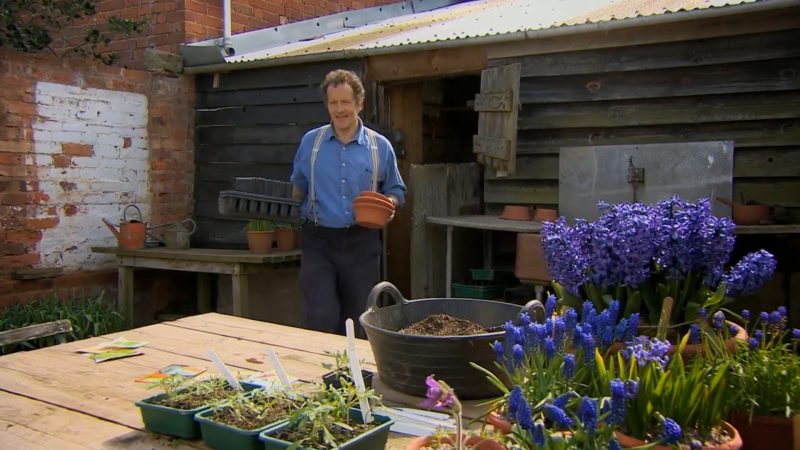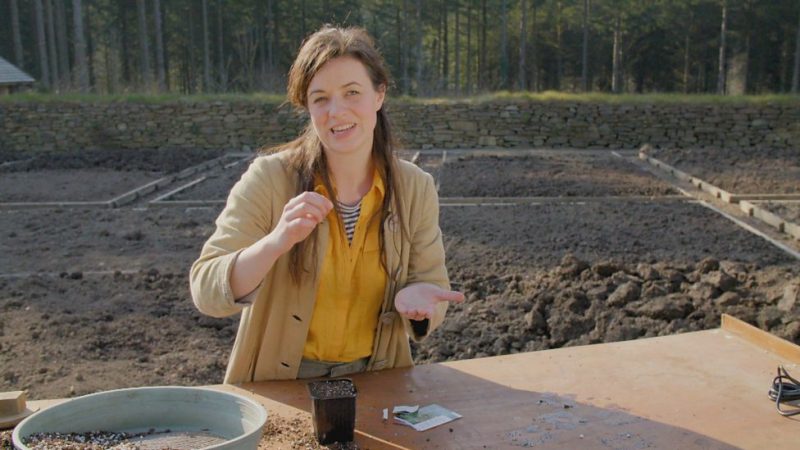Spring is nearly upon us and Gardeners World episode 1 2016 is back with a new series. As usual, Monty Don is at Longmeadow where he sets out his plans for the coming year. This week, Monty reviews the effects the winter weather has had on his garden. As spring edges closer and the days gradually grow longer, Gardeners World makes a welcome return for the 2016 series. The show is a harbinger of the new season, inspiring viewers to dust off their garden tools and prepare for the promise of warmer days. Leading the show is Monty Don, a familiar face who has become synonymous with the program. With his wealth of knowledge and decades of gardening experience, he gently guides viewers through the joys and challenges of gardening throughout the seasons.
In this inaugural episode – Gardeners World episode 1 2016, Monty invites us back to his garden at Longmeadow. This verdant space, which has been nurtured and transformed by Monty over many years, serves as the backdrop for the series. It’s here where he demonstrates gardening techniques, introduces various plant species, and shares his wisdom with the viewers. At the dawn of a new gardening year, Monty outlines his plans for the upcoming months, providing a roadmap for viewers to follow in their own gardens.
However, before new plans can be executed, it’s crucial to assess the effects of the winter season on the garden. Winter weather can have a profound impact on the landscape, with freezing temperatures, frost, snow, and biting winds potentially causing damage. This week, Monty takes the time to inspect his garden for signs of winter damage and offers advice on how to repair and rejuvenate areas that have been affected. This involves a careful survey of the garden, paying attention to how plants have fared in the winter chill. Carol Klein visits a Welsh hillside garden and delves into the botany of bulbs with a couple who have used a scientific approach to plant their garden with the earliest of spring flowers.
It is the perfect time of year to plant trees and Joe Swift gives us his guide to choosing the best ones for our gardens. And there is a glimmer of hope for gardeners who have had to cope with copious amounts of rainfall this year when we visit a garden which, last year, was brought back from the brink of destruction with spectacular results.
Gardeners World episode 1 2016:
Snowdrops
For welcome assurance that the brighter days of spring are on their way, look no further than snowdrops (Galanthus). They are surprisingly varied in height, flower size, shape and even colouring. Given a moist soil they will multiply into drifts and provide plenty of plants to share with fellow gardeners. Snowdrops are among the first flowers to bloom in late winter and early spring. They are native to Europe and Asia, but have been introduced to other regions as ornamental plants. Snowdrops have white, bell-shaped flowers that hang from slender stems. The flowers have six petals, three of which are larger and more curved than the others. The leaves are narrow and green, often with a silvery stripe along the middle.
Snowdrops are not only beautiful, but also have a rich history and symbolism. They are associated with purity, hope, rebirth and resilience. In some cultures, they are considered a sign of good luck or a harbinger of spring. In others, they are linked to sorrow or death. Snowdrops have also inspired many legends, poems and artworks over the centuries.
Snowdrops can be grown in gardens or containers, as long as they have moist, well-drained soil and partial shade. They prefer cool temperatures and will not tolerate heat or drought. Snowdrops can be propagated by dividing the bulbs after flowering or by sowing seeds in autumn. Galanthus are generally pest-free and deer-resistant, but may be affected by some fungal diseases or bulb rot.
Snowdrops are a delight to see in the bleak days of winter. They remind us that spring is on its way and that life persists even in the harshest conditions. Snowdrops are a symbol of hope and beauty that can brighten up any garden or home.
Growing raspberries – Gardeners World episode 1 2016
Raspberries are really popular garden fruits and are very easy to grow. Try growing both summer and autumn-fruiting varieties: just a few plants will reward you with plenty of fruit from midsummer until mid autumn. If you end up with a glut, raspberries also freeze well, and make wonderful jams, sauces and cooked desserts. Growing raspberries is a rewarding and delicious hobby that anyone can enjoy. Raspberries are easy to grow, require little maintenance, and produce abundant fruits in the summer and fall. Here are some tips on how to grow raspberries in your backyard or garden.
1. Choose a sunny spot with well-drained soil. Raspberries prefer full sun and rich, loamy soil that drains well. Avoid planting raspberries in low-lying areas where water may accumulate or in clay soils that retain moisture. You can improve your soil by adding organic matter such as compost or manure before planting.
2. Prepare the planting site. Raspberries grow best in raised beds or rows that are about 3 feet wide and 8 inches high. This helps to improve drainage and air circulation around the plants. Dig a trench along the center of the bed or row and fill it with compost or well-rotted manure. This will provide nutrients and moisture for the raspberry roots.
3. Plant the raspberry canes. Raspberries are propagated by canes, which are long stems that grow from the base of the plant. You can buy raspberry canes from nurseries or online suppliers, or you can use canes from an existing raspberry patch. The best time to plant raspberries is in early spring or late fall, when the plants are dormant. Space the canes about 18 inches apart in the trench and cover them with soil, leaving about 2 inches of the cane exposed above the ground.
4. Support the raspberry plants. Raspberries need some support to keep them upright and prevent them from sprawling over the ground. You can use stakes, trellises, or wires to support your raspberry plants. The simplest method is to drive two stakes at each end of the row and run a wire between them at about 3 feet high. Then, tie the raspberry canes loosely to the wire as they grow.
5. Prune and mulch the raspberry plants. Raspberries need regular pruning to keep them healthy and productive. There are two types of raspberries: summer-bearing and fall-bearing. Summer-bearing raspberries produce one crop of berries in early summer, while fall-bearing raspberries produce two crops: one in late summer and one in fall. The pruning method depends on the type of raspberry you have.
- For summer-bearing raspberries, prune all the canes that bore fruit in the previous year to the ground in late winter or early spring. Leave about 6 to 8 healthy canes per foot of row for the next season’s crop.
- For fall-bearing raspberries, prune all the canes to the ground in late winter or early spring. This will eliminate the summer crop, but will result in a larger and better quality fall crop.
Mulching your raspberry plants helps to conserve moisture, suppress weeds, and protect the roots from temperature extremes. You can use organic materials such as straw, wood chips, or pine needles as mulch. Apply a layer of 2 to 4 inches of mulch around the base of the plants in spring and replenish it as needed throughout the growing season.
6. Harvest and enjoy your raspberries. Raspberries are ready to harvest when they are fully ripe and easily detach from the stem. You can pick them by hand or use a berry picker to collect them faster. Raspberries are delicate and perishable, so handle them gently and store them in a cool place or refrigerate them as soon as possible after picking. You can also freeze, dry, or preserve your raspberries for later use.
Raspberries are not only tasty, but also nutritious and beneficial for your health. They are rich in antioxidants, vitamin C, fiber, and other phytochemicals that may help prevent cancer, diabetes, and cardiovascular diseases. Raspberries also have anti-inflammatory and anti-microbial properties that may help heal wounds and infections.
Growing raspberries is a fun and rewarding way to enjoy fresh fruits from your own garden. With proper care and maintenance, you can have a bountiful harvest of raspberries every year.
Growing peppers and chillies – Gardeners World episode 1 2016
Sweet peppers and chillies can be grown in pots on a sunny, warm patio in a similar way to tomatoes, but will produce a better crop when grown in a greenhouse or conservatory. Chillies and peppers are green when young, maturing to a variety of colours and flavour varying from mild to extremely hot. Growing peppers and chillies is a rewarding and fun hobby for many gardeners. Peppers and chillies belong to the same plant family, Capsicum, and have similar growing requirements. They need a warm, sunny and humid environment to produce well, and they can be grown in pots or in the ground.
To grow peppers and chillies from seed, you need to start them indoors in late winter or early spring. Sow the seeds in moist, peat-free compost and keep them in a heated propagator or a warm windowsill. When the seedlings have their first true leaves, transplant them into individual pots and keep them in a bright place.
When the weather is warm enough, you can move your pepper and chilli plants outside. Choose a sheltered spot that gets at least six hours of sun a day, and protect them from cold nights and strong winds. You can also grow them in a greenhouse, polytunnel or conservatory if you have one.
Water your plants regularly and feed them with a high-potash fertiliser once they start flowering. Pinch out the growing tips of your plants to encourage bushy growth and more fruits. You can also mist your plants with water to increase humidity and prevent pests.
You can harvest your peppers and chillies when they are green or wait until they ripen to their final colour, which is usually red or yellow. The ripened fruits will have a sweeter flavour and more heat. Cut them off with scissors or a sharp knife and enjoy them fresh or preserve them for later use.




